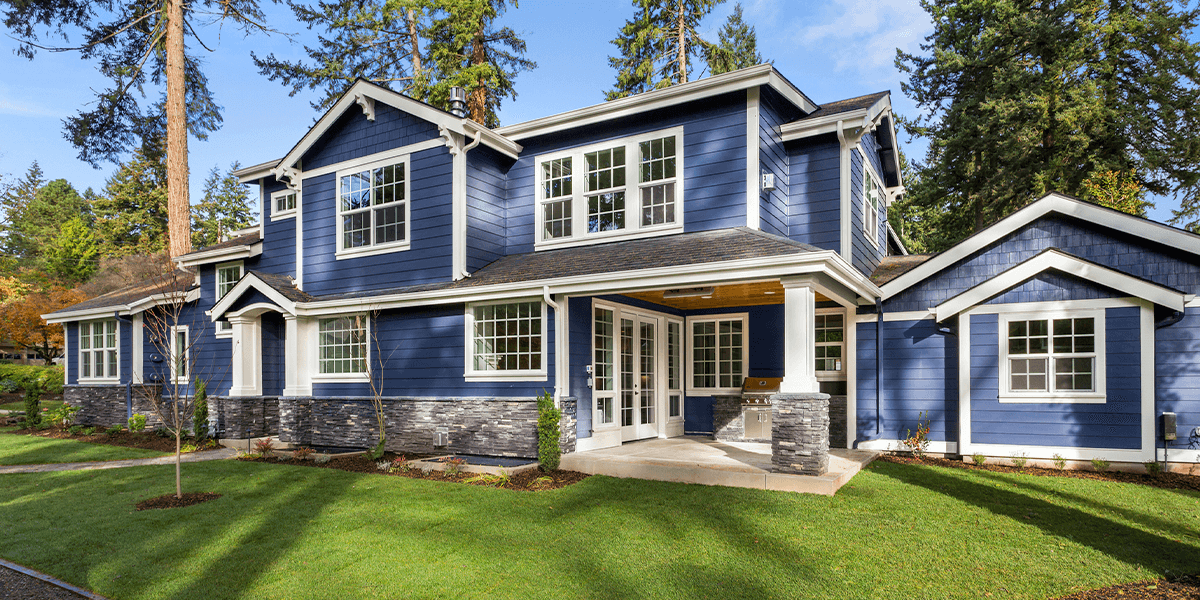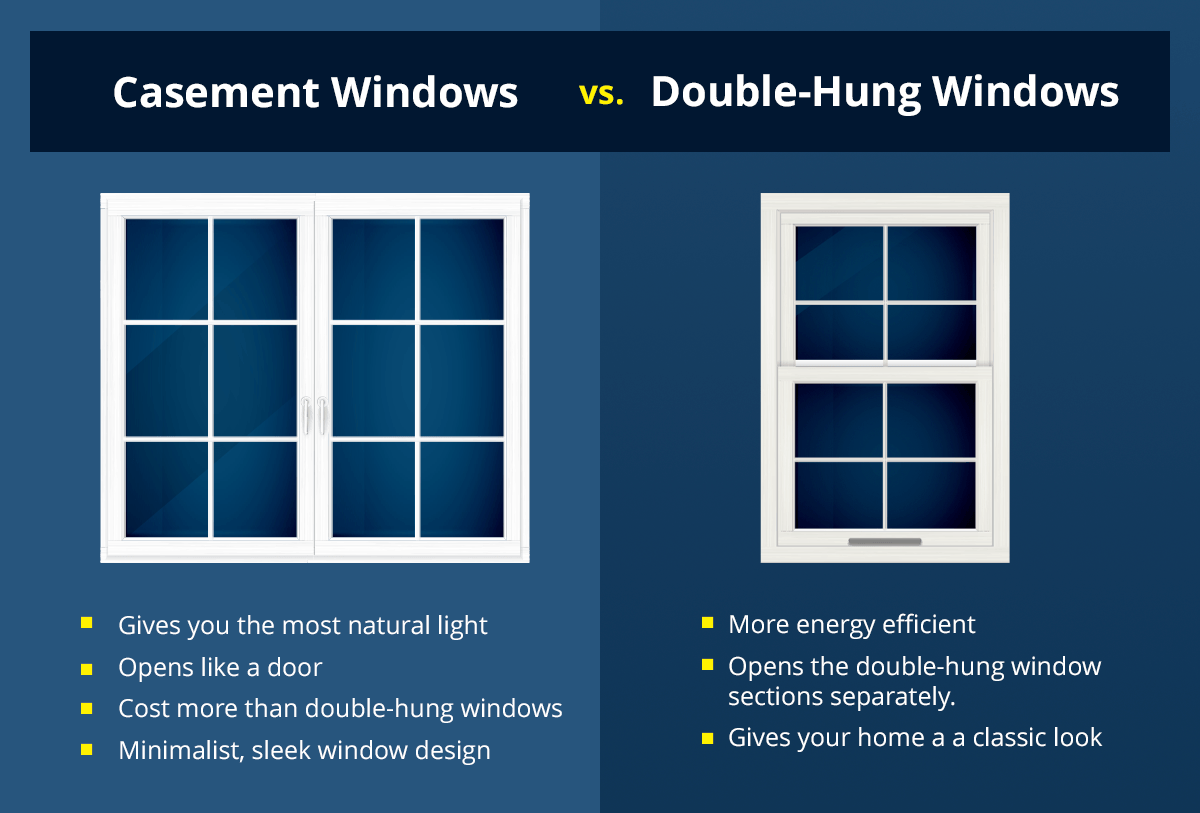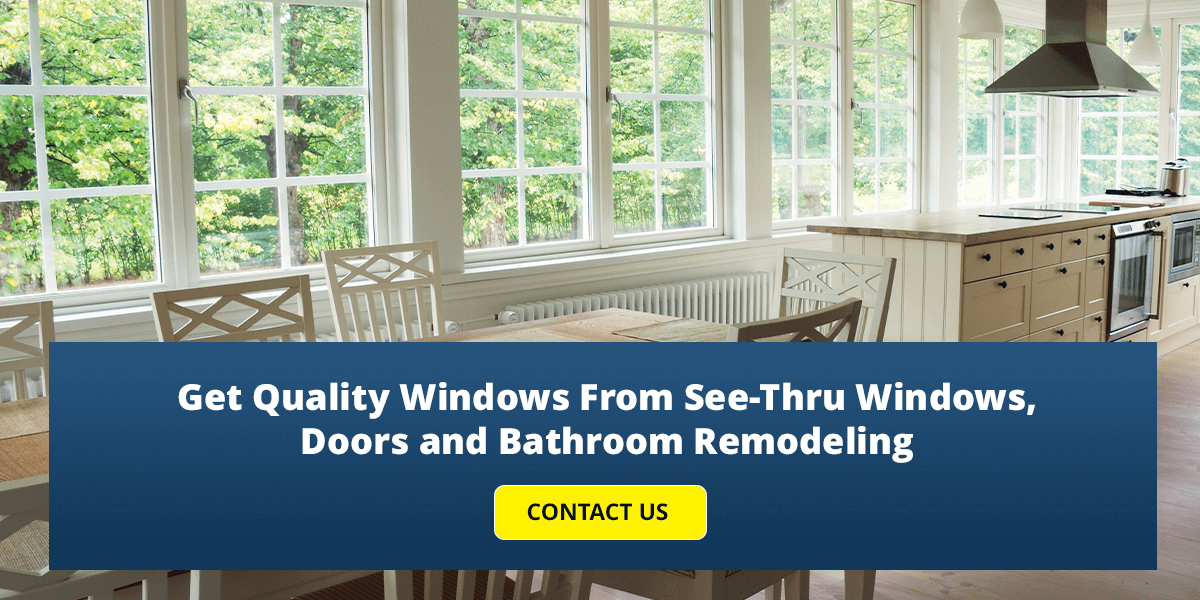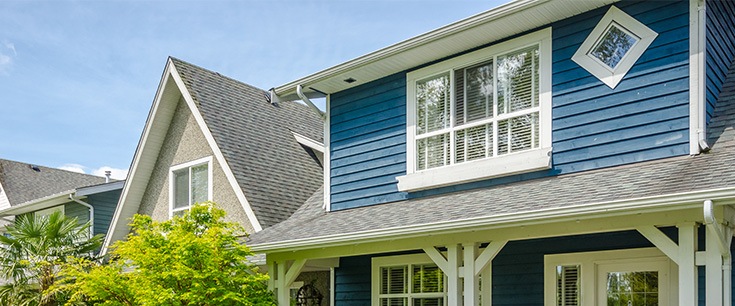
Casement vs. Double-Hung Windows
Picking new windows for your home can be challenging. Choosing between different types, styles and design options can leave you with more possibilities than you expected. In your search, you’ll come across casement windows vs double-hung windows. These are two popular window choices for homes, and each one can deliver a unique style and efficiency to your space. Compare casement and double-hung windows to pick the best fit for your home.
What Are Casement Windows?
Casement windows are tall, hinged windows that swing open like little doors. They feature a clear glass rectangle, without rails and bars obstructing part of the glass that you see on other window types. Casement windows are popular thanks to their energy efficiency, easy maintenance and versatility. Their design lets you open them outwards like a door, providing easy cleaning access. Casement windows‘ sleek design also lets in lots of natural light and gives you many style options that fit your unique tastes.
If you’re looking for a timeless window design, you can use casement windows in your modern and traditional homes. These windows are particularly appealing for contemporary-style homes due to their simplicity and clean lines, which complement the minimalistic aesthetics of modern architecture. On the other hand, choose double-hung windows for their classic appeal that harmonizes beautifully with traditional architectural styles like Colonial or Cape Cod. With more options for opening these windows, you can easily adjust your natural temperature control as needed. Homeowners looking for flexible, practical, and attractive windows will love having double-hung windows on their home, especially if they are aiming to maintain the historical integrity of traditional designs.
What Are Double-Hung Windows?
Double-hung windows are another popular window style. They have two sliding vertical sashes, while single-hung windows only have one moveable sash. The top and bottom sashes of double-hung windows can move independently, letting you customize your airflow and comfort. They often have sashes that can tilt inward, letting you easily clean the exterior.
Double Hung Windows also work with different architectural styles while giving your home a classic look. With more options for opening these windows, you can easily adjust your natural temperature control as needed. Homeowners looking for flexible, practical and attractive windows will love having double-hung windows on their home.
What’s the Difference Between Casement vs. Double-Hung Windows?
Casement vs double-hung windows are two quality window options. If you’re looking for a window upgrade, you’ll want to compare different window types to help you find the right fit for your home. While your budget matters, understanding what each window type offers will help you get the best window for your needs. Here are some main areas to look at when choosing between double-hung and casement windows. Double-hung windows are designed with two sashes, an upper and a lower, which both slide vertically within the frame.
This design allows you the flexibility to open the window from either the top or the bottom, providing a significant safety feature particularly useful if you have small children or pets. On the other hand, casement windows are attached to their frames by hinges at the side and open outward like a door. They are typically operated using a cranking mechanism and securely closed with a lever lock. This mechanism can be easier to operate for some people, especially in hard-to-reach areas. Each type of window presents its own advantages depending on your specific needs, such as ventilation, ease of use, and safety considerations, making it important to consider these operational differences when making your decision.
Both casement and double-hung windows can offer excellent energy performance with the right model and insulation. Casement windows feature a tight seal and crank design. These features let them deliver improved insulation and energy conservation while closed. You’ll see reduced drafts and minimal leaks, keeping your home comfortable and your energy bills down. The crank mechanism lets you close the window securely, keeping your home at your desired temperature regardless of the weather. Double-hung windows are slightly more energy efficient than casement windows. If you maintain your windows and invest in a quality window installer, you’ll get an extremely tight, efficient seal.
Moreover, both window types can be constructed using the same high-quality materials, ensuring durability and long-term performance. Whether you choose casement or double-hung windows, you can have them made with high-efficiency double- or triple-paned glass, which greatly enhances their insulative properties. Additionally, these windows are available in a variety of framing materials, including durable vinyl, which not only supports the structure but also contributes to the overall energy efficiency by reducing thermal transfer. This commonality in construction materials between the two types means that no matter your preference, you can achieve excellent energy conservation and a cohesive aesthetic throughout your home.

Light
Both casement and double-hung windows will let natural light into your home, but they have different light exposure levels. If maximizing natural light is important to you, casement windows will give you the most natural light. Their design means light traveling through your window is completely unobstructed. You’ll enjoy all the sunlight you want with nothing dividing the panes. If your home design emphasizes natural light, you’ll get perfect views of the outside and tons of sun streaming into your home every day.
Conversely, double-hung windows feature divided sashes, which block some sunlight from getting in. While they still let in natural light, the horizontal block can slightly reduce the sense of openness you get with casement windows. It’s not a significant light blockage, but you’ll need to consider your light goals and home design when picking a window to help you get the look you want.
Energy-Efficiency
Energy efficiency is a key consideration for many homeowners. Your windows are responsible for 25-30% of your heating and cooling energy use — they directly influence how much heat and cold travel in and out of your home. To decrease your energy loss and bills, invest in reliable, energy-efficient types of windows. Both casement and double-hung windows can offer excellent energy performance with the right model and insulation.
Casement windows feature a tight seal and crank design. These features let them deliver improved insulation and energy conservation while closed. You’ll see reduced drafts and minimal leaks, keeping your home comfortable and your energy bills down. The crank mechanism lets you close the window securely, keeping your home at your desired temperature regardless of the weather.
Double-hung windows are slightly more energy efficient than casement windows. If you maintain your windows and invest in a quality window installer, you’ll get and extremely tight, efficient seal. You’ll create a lasting seal against the elements with overlapping sashes and added weatherstripping features. Talk to your window installer about energy-efficient options to ensure you get the best option.
Use
If you’re going to use your windows a lot, you want something that opens and closes easily. Casement windows are popular thanks to their expansive views and simple use. The crank mechanism lets you open the window like a door, adjusting the openness to your preference. You’ll have quick access to the outside and easy use for cleaning and maintenance. Casements are especially good for rooms that need regular ventilation, like bathrooms and kitchens. They can easily sit open by themselves, and their tall design brings lots of air inside when needed.
Double-hung windows deliver a different ventilation style. Instead of the wide, open-swinging casement window, you can open your double-hung window sections separately. You get to customize your window ventilation, letting you adapt it to changing weather. These windows are usually used in bedrooms and living rooms since they feature a classic design and let in slightly less air than casement windows.
Cost
Cost is always going to play an important role in your window upgrade. Since casement windows feature a more complex crank mechanism, they usually cost more than double-hung windows. Double-hung windows are simpler, so you’ll likely pay less per window. Remember that the number of windows, design, materials and energy efficiency all affect your window cost. The better their efficiency and the more sophisticated the model, the more you’ll pay for your windows.
Design
Design aesthetics will also influence your window choice. Casement windows give you a minimalist, sleek window design. Their tall, thinner and clear design complements modern homes or rooms that want lots of light to highlight the interior. With no inner obstructions, you get a better view of the outside and a design that emphasizes the home around the window.
Double-hung windows give your home a timeless charm. The divided sashes add a traditional look to your home, complementing Victorian, farmhouse or colonial-style homes. While each window style looks good with these architectural styles, put your preferences first. Make sure you get a window design that makes you happy and works with your home.
FAQs:
What are the basic differences between double-hung windows and casement windows?
Casement vs double-hung windows are two quality window options. If you’re looking for a window upgrade, you’ll want to compare different window types to help you find the right fit for your home. While your budget matters, understanding what each window type offers will help you get the best window for your needs. Here are some main areas to look at when choosing between double-hung and casement windows.
Double-hung windows are designed with two sashes, an upper and a lower, which both slide vertically within the frame. This design allows you the flexibility to open the window from either the top or the bottom, providing a significant safety feature particularly useful if you have small children or pets. On the other hand, casement windows are attached to their frames by hinges at the side and open outward like a door. They are typically operated using a cranking mechanism and securely closed with a lever lock. This mechanism can be easier to operate for some people, especially in hard-to-reach areas.
Each type of window presents its own advantages depending on your specific needs, such as ventilation, ease of use, and safety considerations, making it important to consider these operational differences when making your decision."
What are the factors to consider regarding access for opening windows, such as height and ease of operation?
When deciding on windows for your home, particularly how they open, it’s important to consider both the height at which they are installed and how easily they can be operated. For instance, certain window styles, such as double-hung windows, may require reaching and lifting which can be difficult from behind large furniture or in high placements, like over a kitchen sink. This can pose a challenge for individuals of shorter stature or those with limited arm strength.
Alternatively, casement windows equipped with crank handles positioned at the bottom provide a more user-friendly solution. This design allows for easier operation without the need to stretch or strain, making them a preferred choice for areas of frequent use. Thus, when evaluating windows, prioritize designs that match the ergonomic needs of all users in the household, ensuring accessibility and ease of operation.
How do screens differ in placement between double-hung windows and casement windows?
In double-hung windows, the screen is typically mounted externally, whereas in casement windows, the screen is installed on the interior. This placement in casement windows ensures that the screen does not obstruct the window’s ability to swing open while still protecting the interior from insects and debris.
What other types of blog posts and information can be found on the See-Thru website related to windows and home improvement?
On the See-Thru blog website, visitors can explore various blog posts that delve into topics concerning windows and home improvement. Some of the featured articles include a guide on modern window designs, styles, and treatments, offering the latest trends and functional advice. There is also content specifically tailored for pet owners, presenting five innovative ideas for pet-friendly window treatments. Additionally, homeowners can benefit from an article discussing the advantages of natural light in homes, providing insightful tips and benefits for enhancing living spaces with sunlight. These posts are part of a broader effort by the website to educate and inspire homeowners regarding effective and aesthetically pleasing home upgrades.
How effective are casement windows in ventilating a space compared to other types of windows?
Due to their ability to act like a sail and catch more direct wind, casement windows are generally more effective in ventilating a space compared to other window types that do not open outward as fully.
What precautions should be taken with casement windows during intense winds?
It is advisable to close casement windows during intense winds to prevent potential damage to the window mechanism and to avoid excessive wind from entering the building.
How does airflow vary between open casement windows and double-hung windows?
Double-hung windows deliver a different ventilation style. Instead of the wide, open-swinging casement window, you can open your double-hung window sections separately. You get to customize your window ventilation, letting you adapt it to changing weather. These windows are usually used in bedrooms and living rooms since they feature a classic design and let in slightly less air than casement windows. Unlike double-hung windows that provide a more controlled and customizable airflow, an open casement window can act like the sail on a sailboat, capturing the wind running alongside a building and directing it inside. This makes casement windows particularly effective in bringing in large volumes of air quickly, though they must be managed carefully in areas with intense winds to avoid the risk of damage during storms.
What are the potential issues with casement windows in certain environmental conditions?
In areas with strong winds, casement windows can be problematic as they need to be closely monitored and potentially closed during storms to avoid damage or excessive airflow that could be disruptive.
How does the design of a casement window affect its ability to capture airflow?
The design of casement windows allows them to open outward fully like a sail, which helps in capturing the wind that flows along the side of a building and directs it inside.
What type of windows is recommended for modern or contemporary-style homes?
Casement windows are recommended for modern or contemporary-style homes due to their simplicity, which complements the architectural style.
What type of windows fits well with traditional home styles like Colonial or Cape Cod?
Double-hung windows with a traditional grid pattern are suitable for traditional home styles such as Colonial or Cape Cod.
What materials can be used to construct both double-hung and casement windows?\r\n
Both types of windows can be constructed using a variety of materials, including durable vinyl among others.
What types of glass can be used in both double-hung and casement windows?\r\n
Both double-hung and casement windows can be equipped with high-efficiency glass options, including double- or triple-paned glass.\r\n
What questions should be asked when choosing a replacement window contractor?
When seeking a contractor for replacement windows, it is vital to conduct a thorough vetting to ensure quality and reliability. Consider asking these questions to make an informed choice:
– Do they operate locally?
– Can they detail the type of warranties provided?
– Could you describe the quality of your customer service?
– Are the installations handled by your own staff or by subcontractors?
– What is the duration of your experience in this industry?
– Is there an option available for financing the project?
These questions will help you gauge the contractor’s capability, reliability, and the quality of their service, ensuring that you choose a well-equipped and trustworthy company for your window replacement needs.
What factors should be considered when buying replacement windows?
When selecting replacement windows, several important considerations must be addressed to ensure they meet your needs and comply with local regulations. Firstly, assess the functionality of the windows based on your specific lifestyle and environmental conditions. For instance, if you reside in a region with hot summers, prioritize windows that provide ample ventilation. Consider the ease of use of features such as removable screens, especially if they are to be frequently cleaned or stored. Additionally, think about the safety and accessibility for all household members, including children and pets who often interact with windows.
Another vital consideration is the window’s location within your home. For example, windows located in hard-to-reach places like above the kitchen sink might benefit from a casement design equipped with a crank for easier operation. It’s also essential to consider the financial aspect of installing different types of windows, as various designs and opening mechanisms may impact the overall cost of the project.
Finally, ensure compliance with local building codes. Check if the new windows meet egress requirements, which are crucial for safety during emergencies, allowing for adequate escape routes and access points for emergency responders. Always discuss these regulations with your window contractor to confirm that your replacement windows are both functional and legally compliant.
How do screens differ in placement between double-hung windows and casement windows?
When deciding on windows for your home, particularly how they open, it’s important to consider both the height at which they are installed and how easily they can be operated. For instance, certain window styles, such as double-hung windows, may require reaching and lifting which can be difficult from behind large furniture or in high placements, like over a kitchen sink. This can pose a challenge for individuals of shorter stature or those with limited arm strength.
Alternatively, casement windows equipped with crank handles positioned at the bottom provide a more user-friendly solution. This design allows for easier operation without the need to stretch or strain, making them a preferred choice for areas of frequent use. Thus, when evaluating windows, prioritize designs that match the ergonomic needs of all users in the household, ensuring accessibility and ease of operation.
How do screens differ in placement between double-hung windows and casement windows?
In double-hung windows, the screen is typically mounted externally, whereas in casement windows, the screen is installed on the interior. This placement in casement windows ensures that the screen does not obstruct the window’s ability to swing open while still protecting the interior from insects and debris.
What other types of blog posts and information can be found on the See-Thru Windows website related to windows and home improvement?
On the See-Thru website, visitors can explore various blog posts that delve into topics concerning windows and home improvement. Some of the featured articles include a guide on modern window designs, styles, and treatments, offering the latest trends and functional advice. There is also content specifically tailored for pet owners, presenting five innovative ideas for pet-friendly window treatments. Additionally, homeowners can benefit from an article discussing the advantages of natural light in homes, providing insightful tips and benefits for enhancing living spaces with sunlight. These posts are part of a broader effort by the website to educate and inspire homeowners regarding effective and aesthetically pleasing home upgrades.
What are the pros and cons of double-hung windows?
Certainly! To answer the question “What are the pros and cons of double-hung windows?”, let’s explore both their advantages and drawbacks.
Advantages of Double-Hung Windows:
1. Cost-Effectiveness: They are typically more affordable compared to other types of windows like casement windows.
2. Safety Features: These windows are considered safer for households with young children or pets due to their secure design.
3. Compatibility with Add-ons: Double-hung windows easily support the installation of window air conditioning units.
4. Ease of Maintenance: Many modern designs of double-hung windows allow for easy cleaning from inside the home, making them convenient for both upper and lower stories.
Disadvantages of Double-Hung Windows:
1. Screen Placement: The screens of double-hung windows are placed outside, which can be less effective in keeping debris and insects out compared to other window types.
2. Ventilation Limitation: These windows often do not provide as much ventilation as casement windows because they open vertically rather than outwards.
3. View Obstruction: The presence of a horizontal rail in double-hung windows can sometimes obstruct the view to the outside, which might be undesirable for those wanting unobstructed scenery.
These pros and cons show that while double-hung windows are a practical and economical choice, they may have some limitations in terms of ventilation and view.
What are the pros and cons of casement windows?
Casement windows offer a variety of benefits and drawbacks that homeowners should consider when deciding on window styles for their home.
Pros:
1. Aesthetic Flexibility: These windows can enhance modern aesthetics or seamlessly integrate with existing architectural elements.
2. Clear Views: Their design allows for a wide, unobstructed field of view.
3. Low Maintenance: They typically require minimal maintenance and are designed for durability.
4. Enhanced Ventilation: The ability to open fully outward maximizes airflow, making them perfect for aiding natural cooling during warmer seasons.
5. Cleaning Convenience: They can be easily cleaned from the inside, which reduces the hassle and risk associated with window maintenance.
Cons:
1. Cost: Casement windows can be more expensive compared to other styles such as double-hung windows.
2. Incompatibility with Certain Add-ons: These windows cannot accommodate window-mounted air conditioners due to their outward swinging design.
Get Quality Windows From See-Thru Windows, Doors and Bathroom Remodeling
Your windows can make or break your home’s design. If you’re looking to upgrade your home’s windows, bathrooms or entry doors, we’re here to help. Our windows and doors meet the American Architectural Manufacturer’s Association standards, and we have 20 years of industry experience serving Maryland and Virginia. Contact us online to learn more and get started on your window upgrade today!




